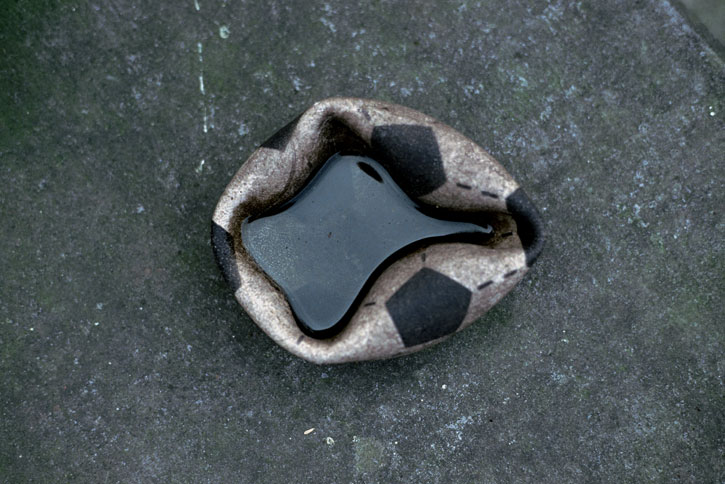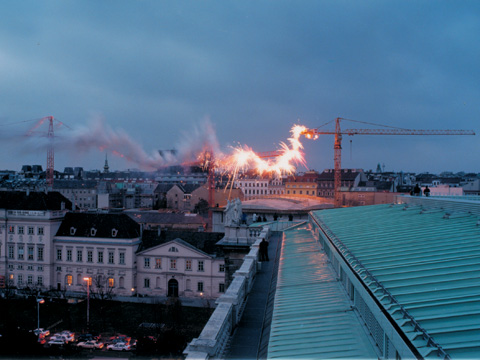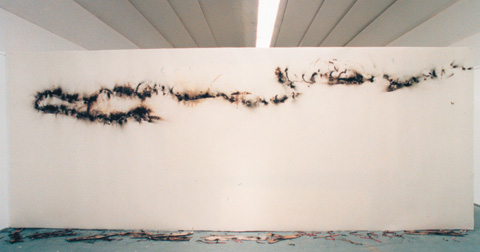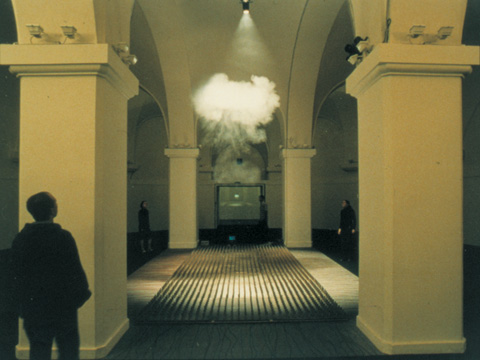Sculpture Studio Portfolio (SP10)
/Caitie Harrigan
Project 1: Process
ARTIST RESEARCH
Gabriel Orzoco and Cai Guo-Qiang
Both Gabriel Orozco and Cai Guo-Qiang frequently explore process to change perception and increase awareness, largely influenced by time. For Orozco, this is most clearly expressed by his capturing drawings and sculptures in every day life through photos. Guo-Qiang is most famous for his fireworks and use of gunpowder in both drawings and sculptures that could last anywhere between a few seconds to many months that often have an environment meaning behind them.
Orozco works without a fixed studio. Instead, he explores his surroundings, often using found objects to create temporary sculptures and drawings, which he captures with a camera and keeps in notebooks. For example, Pinched Ball (1993) is a photograph of a deflated soccer ball that created a temporary pool of water. One would assume that the form of the deflated ball, the shape of the pool because of the ball, and the unusualness of a deflated ball as a cup were all reasons that the object struck Orozco as sculpture-like and compelled him to photograph it. Breath on Piano (1993) is a captured moment of the pattern a hot breath created on a shiny piano. Orozco could have been intrigued by the shiny black surface of the piano and wanted to counter it with the unique pattern that moisture of a warm breath makes, breaking up the flawless polish, and suggesting an unseen presence. Orozco also controls and changes scenarios to create his temporary sculptures, such as Cats and Watermelons (1992). In this piece, assumedly Orozco has placed a can of cat food on each watermelon at a stand. Because all of the cat faces are looking at the camera, it looks like they are cats with watermelon bodies. Stepping back, the simple parallel between these two objects repeated eleven times is striking and unusual in itself.
Pinched Ball (1993), Breath on Piano (1993)
Orozco’s process involves finding, creating, and recording moments of every day life and objects, forcing the viewer to look at them in a way as pieces of art themselves, or as Peter Schjeldahl writes, “contemplat[ing] without prejudice […] the art part is a triggered awareness that the world teems with vernacular loveliness.” Pinched Ball, Breath on Piano, and Cats and Watermelons are all examples of this, and were both ephemeral objects that the viewer can appreciate as art with the help of Orozco, who challenges the viewer to look at them objectively. In simple terms, a person who walks down the same street every day might not be paying attention to the objects around him. Orozco might take a picture from that street and the person's first impulse would be, "Why is that so special?" Orozco's basic aim is to force people to look at objects without discrimination.
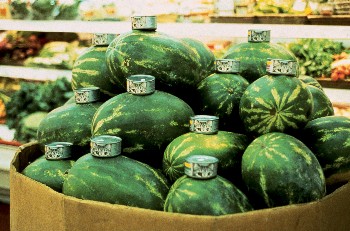
Cats and Watermelons (1992)
For Orozco, his process is all about changing perception, even when it involves drawing a precise pattern of checkers with graphite on a human skull (Black Kites, 1997) or cutting out all the numbers of a NYC telephone book and pasting them on a long scroll of Japanese paper (Dial Tone, 1992). Orozco has changed the skull in Black Kites from something organic and natural to more mechanical or artificial because of the dark strict pattern that acts as a grid over the cranium. In Dial Tone, Orozco has taken an everyday object with little personality or uniqueness, telephone numbers, and made them into, “a kind of landscape,” in his own words.
Black Kites (1997), Dial Tone (1992)
Guo-Qiang’s process employs time in his artwork in a different kind of way. He is most well known for using fireworks and gunpowder as his mediums. Some of his installations are vast, one-time only explosions, such as in Dragon Sight Sees Vienna: Project for Extraterrestrials No. 32 (1999), and others are set, reoccurring events, such as the black cloud appearing at noon every day in Clear Sky Black Cloud (2006). In Dragon Sight Sees Vienna, because the fireworks are so stunning yet so short (15 seconds), the viewer cannot help to be reminded of the impermanence of things, especially the beauty of nature. In Clear Sky Black Cloud, the piece acts as a foreboding sign because of the negative connotations of a black cloud against a clear sky and its daily reoccurrence. Guo-Qiang works to combine the beauty of nature and objects with an awareness of their lives. An author wrote for the Guggenheim, "The structure of Cai’s art forms are inherently unstable, but his social idealism characterizes all change, however violent, as carrying the seeds of positive creation."
Clear Sky Black Cloud (2006), Dragon Sight Sees Vienna: Project for Extraterrestrials No. 32 (1999)
His process of drawings is created by controlled explosions of different types of fireworks for different lengths of time for variation in color and amount of paper burning. This produces a very distinct style that emphasizes the process of creation out of destruction. An example of this is the drawing for Dragon Sight Sees Vienna: Project for Extraterrestrials No. 32 (1999) mentioned above.
Drawing for Dragon Sight Sees Vienna: Project for Extraterrestrials No. 32 (1999)
Another type of process Guo-Qiang explores is public participation to create and form his work. In general, his larger firework installations depend on an audience; otherwise they would never be seen and therefore lost. In other installations, Guo-Qiang formats the piece to be configured by the public: in I Am the Y2K Bug (1999), the explosions, creating a mushroom cloud, would go off according to where an unsuspecting person would step.
I Am the Y2K Bug (1999)
Both artists’ work orients towards process being equally important as the end product. For Orzoco, the process of much of his artwork is the fact that he explores the world looking for something that strikes him to photograph or something with which he can make a temporary sculpture or drawing. For Guo-Qiang, most of his artwork is based on the process itself; such as the shapes and forms the fireworks create when they explode or how they burn the paper, which he controls to make his drawings.
References:
"Cai Guo-Qiang: I Want to Believe." http://pastexhibitions.guggenheim.org/cai/cai_overview.html 2008. (February 2, 2009)
“Gabriel Orozco.” White Cube (2009).
Guo-Qiang, Cai. Cai Guo-Qiang. London; New York, Phaidon, 2002.
Guo-Qiang, Cai. Transparent Monument. Edizioni Charta, 2006.
Roberta Smith. “Cars and Gunpowder and Plenty of Noise.” The New York Times (2008).
Schjeldahl, Peter. “Man of the World: A Gabriel Orozco Retrospective.” The New Yorker (2009).
Vitamin D: New Perspectives in Drawing. London, Phaidon Press Limited, 2005.
Back to Index
This page was last updated:
February 16, 2010 4:17 PM
